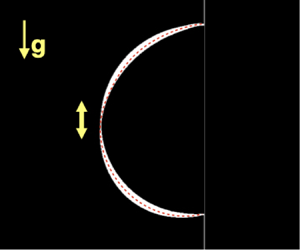Article contents
A model to predict the oscillation frequency for drops pinned on a vertical planar surface
Published online by Cambridge University Press: 08 October 2021
Abstract

Accurate prediction of the natural frequency for the lateral oscillation of a liquid drop pinned on a vertical planar surface is important to many drop applications. The natural oscillation frequency, normalized by the capillary frequency, is mainly a function of the equilibrium contact angle and the Bond number ( $Bo$), when the contact lines remain pinned. Parametric numerical and experimental studies have been performed to establish a comprehensive understanding of the oscillation dynamics. An inviscid model has been developed to predict the oscillation frequency for wide ranges of
$Bo$), when the contact lines remain pinned. Parametric numerical and experimental studies have been performed to establish a comprehensive understanding of the oscillation dynamics. An inviscid model has been developed to predict the oscillation frequency for wide ranges of  $Bo$ and the contact angle. The model reveals the scaling relation between the normalized frequency and
$Bo$ and the contact angle. The model reveals the scaling relation between the normalized frequency and  $Bo$, which is validated by the numerical simulation results. For a given equilibrium contact angle, the lateral oscillation frequency decreases with
$Bo$, which is validated by the numerical simulation results. For a given equilibrium contact angle, the lateral oscillation frequency decreases with  $Bo$, implying that resonance frequencies will be magnified if the drop oscillations occur in a reduced gravity environment.
$Bo$, implying that resonance frequencies will be magnified if the drop oscillations occur in a reduced gravity environment.
JFM classification
- Type
- JFM Papers
- Information
- Copyright
- © The Author(s), 2021. Published by Cambridge University Press
References
REFERENCES
- 6
- Cited by



